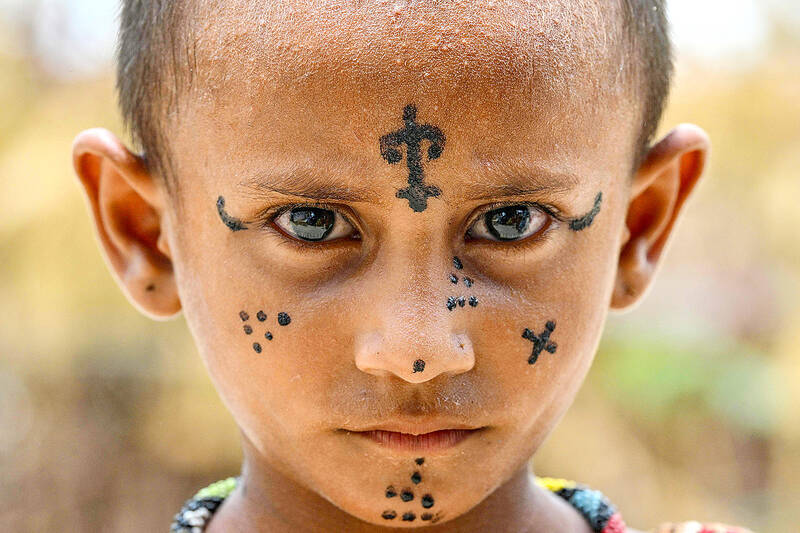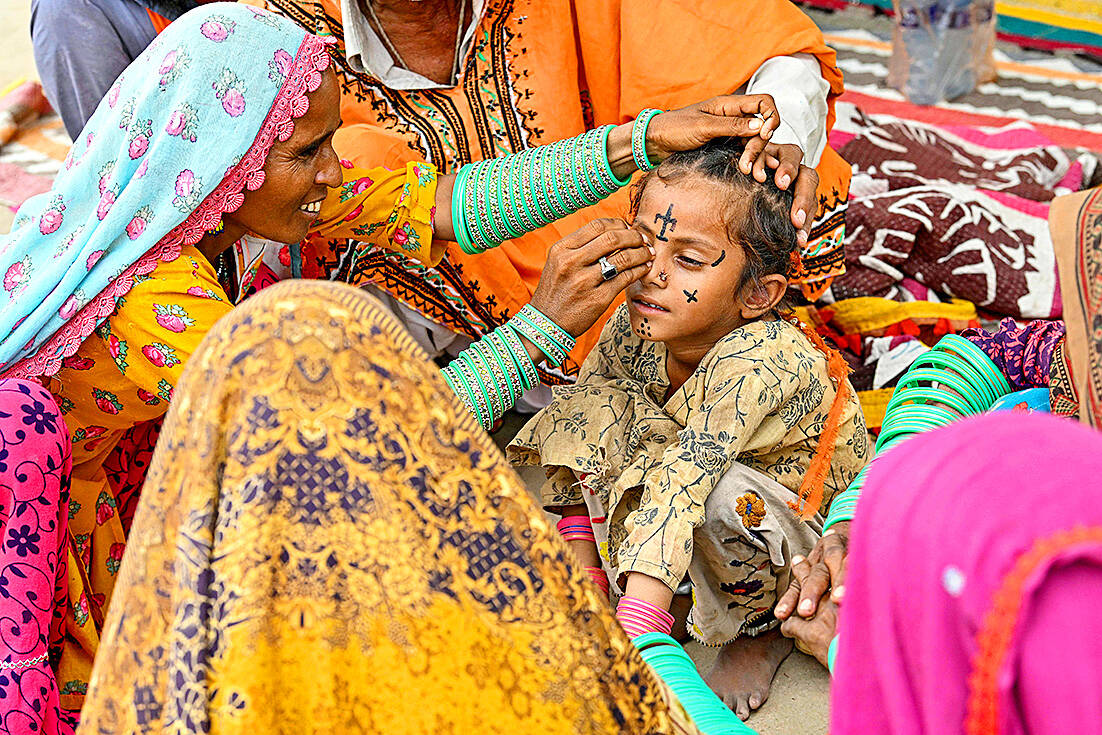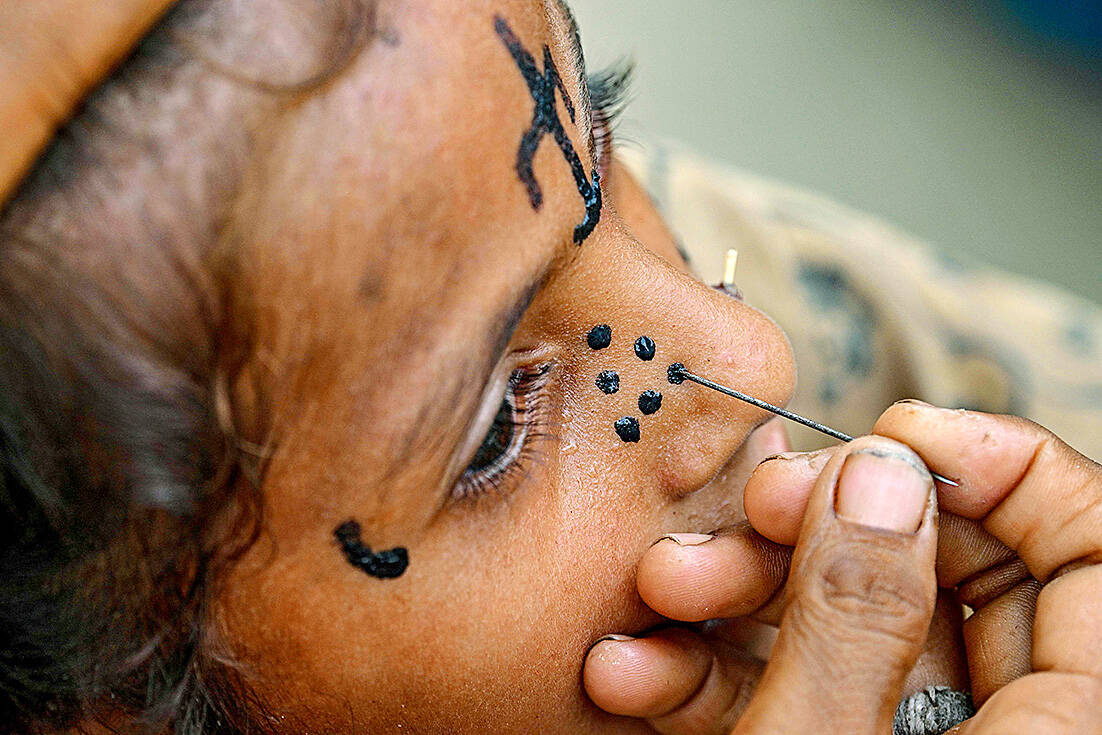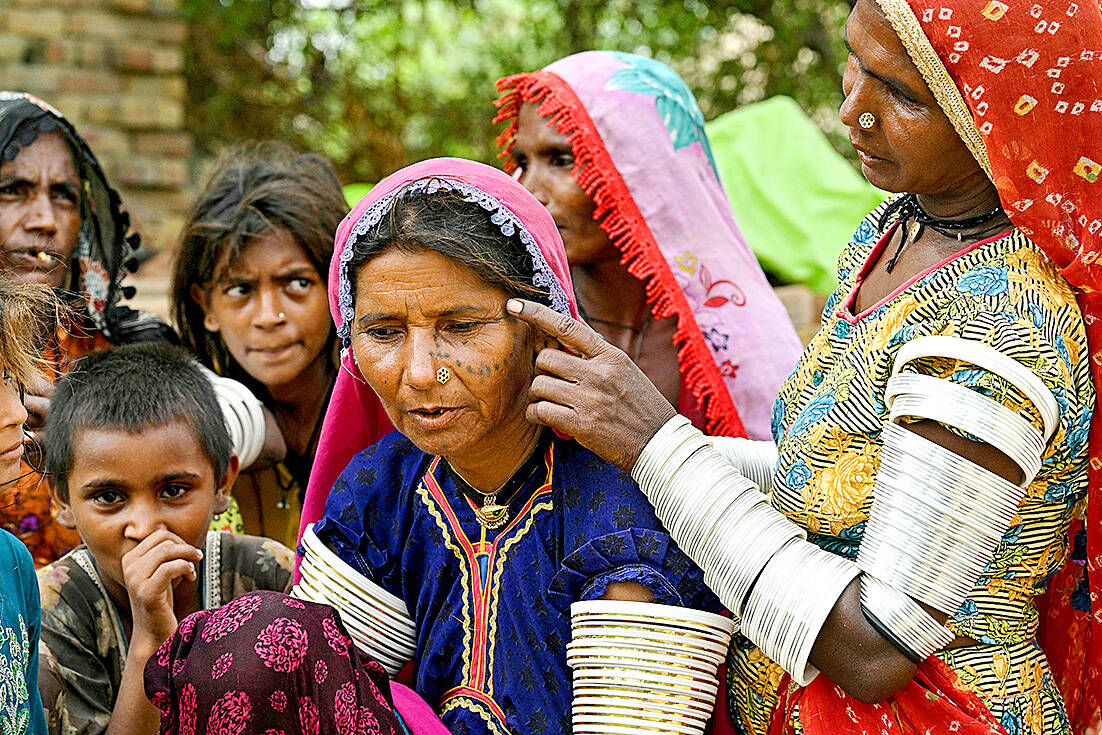Grinding charcoal with a few drops of goat’s milk, 60-year-old Basran Jogi peers at the faces of two small Pakistani sisters preparing for their first tattoos.
The practice of elder women needling delicate shapes onto the faces, hands and arms of younger generations stretches back centuries in the Hindu villages that dot the southern border with India.
“First draw two straight lines between the eyebrows,” Jogi instructs her friend poised with a sewing needle.

“Now insert the needle along the lines — but slowly, until it bleeds.”
Six-year-old Pooja barely winces as dotted circles and triangles are tattooed onto her chin and forehead.
On the outskirts of the rural town of Umerkot in Sindh province, her seven-year-old sister Champa declares eagerly beside her that “I am ready too.”

Photo: AFP
In recent years, however, as rural Hindu communities in Muslim-majority Pakistan become more connected to nearby cities, many young women have opted out of the “old ways.”
“These signs set us apart from others,” said 20-year-old Durga Prem, a computer science student who grew up in the nearby city of Badin.
“Our generation doesn’t like them anymore. In the age of social media, young girls avoid facial tattoos because they think these marks will make them look different or unattractive.”

Photo: AFP
Her sister Mumta has also refused to accept the tattoos that mark their mother and grandmothers.
“But if we were still in the village, we might have had these marks on our faces or arms,” she reflects.
WARD OFF EVIL SPIRITS

Photo: AFP
Just two percent of Pakistan’s 240 million people are Hindu, and the majority live in rural areas of southern Sindh province.
Discrimination against minorities runs deep and Hindu activist Mukesh Meghwar, a prominent voice for religious harmony, believes younger generations do not want to be instantly identified as Hindu in public.
Many Muslims believe tattoos are not permissible in Islam, and even those who have them rarely display them in public.
“We can’t force our girls to continue this practice,” Meghwar said. “It’s their choice. But unfortunately, we may be the last generation to see tattoos on our women’s faces, necks, hands and arms,” he said.
Few Hindus recalled the meaning behind the practice of tattoos or when it began, but anthropologists believe it has been part of their cultural heritage for hundreds of years.
“These symbols are part of the culture of people who trace their roots to the Indus civilization,” said anthropologist Zulfiqar Ali Kalhoro, referring to a Bronze Age period that pre-dates modern religion.
“These ‘marks’ were traditionally used to identify members of a community” and to “ward off evil spirits,” he adds. Admiring the work on the grinning faces of the two little sisters, elder Jogi agreed that it was an ancestral tradition that enhanced the beauty of women.
“We don’t make them for any specific reason — it’s a practice that has continued for years. This is our passion,” she said.
The marks that begin dark black quickly fade to a deep green color, but last a lifetime.
“They belong to us,” said Jamna Kolhi, who received her first tattoos as a young girl alongside Jogi. “These were drawn by my childhood friend — she passed away a few years ago,” said 40-year-old Jamna Kolhi.
“Whenever I see these tattoos, I remember her and those old days. It’s a lifelong remembrance.”

The Nuremberg trials have inspired filmmakers before, from Stanley Kramer’s 1961 drama to the 2000 television miniseries with Alec Baldwin and Brian Cox. But for the latest take, Nuremberg, writer-director James Vanderbilt focuses on a lesser-known figure: The US Army psychiatrist Douglas Kelley, who after the war was assigned to supervise and evaluate captured Nazi leaders to ensure they were fit for trial (and also keep them alive). But his is a name that had been largely forgotten: He wasn’t even a character in the miniseries. Kelley, portrayed in the film by Rami Malek, was an ambitious sort who saw in

It’s always a pleasure to see something one has long advocated slowly become reality. The late August visit of a delegation to the Philippines led by Deputy Minister of Agriculture Huang Chao-ching (黃昭欽), Chair of Chinese International Economic Cooperation Association Joseph Lyu (呂桔誠) and US-Taiwan Business Council vice president, Lotta Danielsson, was yet another example of how the two nations are drawing closer together. The security threat from the People’s Republic of China (PRC), along with their complementary economies, is finally fostering growth in ties. Interestingly, officials from both sides often refer to a shared Austronesian heritage when arguing for

Among the Nazis who were prosecuted during the Nuremberg trials in 1945 and 1946 was Hitler’s second-in-command, Hermann Goring. Less widely known, though, is the involvement of the US psychiatrist Douglas Kelley, who spent more than 80 hours interviewing and assessing Goring and 21 other Nazi officials prior to the trials. As described in Jack El-Hai’s 2013 book The Nazi and the Psychiatrist, Kelley was charmed by Goring but also haunted by his own conclusion that the Nazis’ atrocities were not specific to that time and place or to those people: they could in fact happen anywhere. He was ultimately

Nov. 17 to Nov. 23 When Kanori Ino surveyed Taipei’s Indigenous settlements in 1896, he found a culture that was fading. Although there was still a “clear line of distinction” between the Ketagalan people and the neighboring Han settlers that had been arriving over the previous 200 years, the former had largely adopted the customs and language of the latter. “Fortunately, some elders still remember their past customs and language. But if we do not hurry and record them now, future researchers will have nothing left but to weep amid the ruins of Indigenous settlements,” he wrote in the Journal of